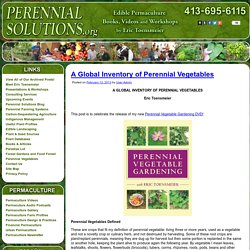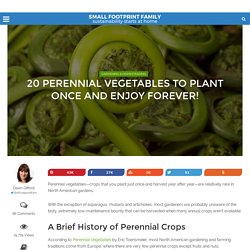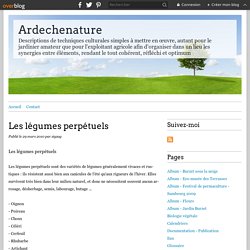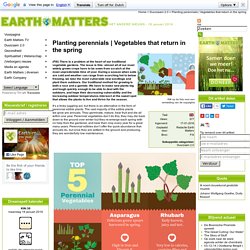

Perennialsolutions. February 12, 2013 User Admin Eric Toensmeier This post is to celebrate the release of my new Perennial Vegetable Gardening DVD!

Perennial Vegetables Defined These are crops that fit my definition of perennial vegetable: living three or more years, used as a vegetable and not a novelty crop or culinary herb, and not destroyed by harvesting. Some of these root crops are plant/replant perennials, meaning they are dug up for harvest but then some portion is replanted in the same or another hole, keeping the plant alive to produce again the following year. Climate Zones These are based on those listed in Perennial Vegetables, which were developed for the US and Canada. The Species This is by no means a comprehensive list. Region of Origin. Perennial Vegetables: Grow More Food With Less Work. Suppose a new agricultural breakthrough promised higher yields, a longer growing season and much less work.

These claims can become real benefits for those willing to make a change to a way of gardening that more closely mimics nature. Perennial Vegetables: Years of Bounty. Perennial vegetables—crops that you plant just once and harvest year after year—are relatively rare in North American gardens.

With the exception of asparagus, rhubarb and artichokes, most gardeners are probably unaware of the tasty, extremely low-maintenance bounty that can be harvested when many annual crops aren’t available. How to Grow Perennial Vegetables. This is the latest offering from the prolific and encyclopedic Martin Crawford of the Agroforestry Research Trust in Devon where he has tested a huge number of plants of all kinds in his two acre forest garden, established 20 years ago.

For a low maintenance, food producing design, such as a forest garden, perennial vegetables can provide an ideal understorey or ground cover accompaniment to a top storey of fruit and nut trees – and Martin has proved that there are a great many such plants available for all niches. The book's design is elegantly straightforward with the first quarter covering the practical issues involved, such as: the reasons for growing perennial veg; how to design them into a garden, and how to grow and look after them. The rest of the book looks at many perennials that can be used productively.
As well as vegetables, also included are grains, tubers, aquatic plants and some vegetatively edible trees. Further resources Plants and recipes to bridge the hungry gap. Perpetual vegetables - garden tips Vavou. Voici une curieuse façon de cultiver un potager mais que les futés du jardinage adopteront volontiers.

Parmi les légumes, un certain nombre peuvent survivre plusieurs années et continuer à produire pendant de longs mois. Plus besoin de labourer, semer et conserver la récolte ! Rustiques, ils peuvent pousser partout en France, parmi les fleurs ou le potager pourvu que l’endroit soit ensoleillé. Les légumes perpétuels sont souvent proches des espèces sauvages aussi leur saveur souvent typée fait le bonheur des gourmets. Perpetual vegetables. Les légumes perpétuels Les légumes perpétuels sont des variétés de légumes généralement vivaces et rustiques : ils résistent aussi bien aux canicules de l'été qu'aux rigueurs de l'hiver.

Elles survivent très bien dans leur milieu naturel, et donc ne nécessitent souvent aucun arrosage, désherbage, semis, labourage, butage ... - Oignon - Poireau - Choux - Céléri - Cerfeuil - Rhubarbe - Artichaut - Bette à tondre (Beta vulgaris var. cicla) - Chénopode Bon-Henri (Chenopodium bonus-henricus) - Chou perpétuel (Brassica oleracea) - Crambé maritime (Crambe maritima) - Cresson de jardin vivace (Barbarea verna) - Oseille épinard (Rumex patienta) - Pimprenelle (Sanguisorba minor) - Poireau perpétuel (Allium ampeloprasum) - Rhubarbe (Rheum rhaponticum) - Roquette vivace (Diploataxis tenuifolia) - Potimarron - Châtaignes - Panais - Crosne - Crosne du japon Le Chervis ombellifère C'est une plante vivace oubliée qui était pourtant présente dans tous les potager au moyen age.
. * Reproduction. Collection of 6 perennial vegetables - Plants and Gardens. 8 Perennial Vegetables For The Lazy Gardener. Over the course of a plant's life cycle, it germinates, grows, flowers, fruits, seeds, and then consequently dies leaving behind seeds for the next generation of plants.

There are three varieties of plant life cycles, annual, biennial, and perennial. Annuals complete their life cycle within a single growing season. Biennials complete their life cycle within two growing seasons. And perennials live for more than two years, repeating the grow to seed process anew every season until the plant dies. Vegetables that return in the spring. (FIX) There is a problem at the heart of our traditional vegetable gardens.

The issue is this: almost all of our most widely grown crops have to be sown from scratch at the most unpredictable time of year. During a season when soils are cold and weather can range from scorching hot to below freezing, we take the most vulnerable new seedlings and plant them outdoors. Our traditional method for growing is both a race and a gamble. We have to make new plants big and tough quickly enough to be able to deal with the outdoors, and hope their decreasing vulnerability and the increasing outdoor temperatures intersect at the sweet spot that allows the plants to live and thrive for the season.
It’s a tricky juggling act, but there is an alternative in the form of perennial edible plants. One of the great benefits perennial vegetables have over annuals is that many of them appear early in the year. Perennial vegetables don’t just make life easier for the gardener, they suit the soil too.